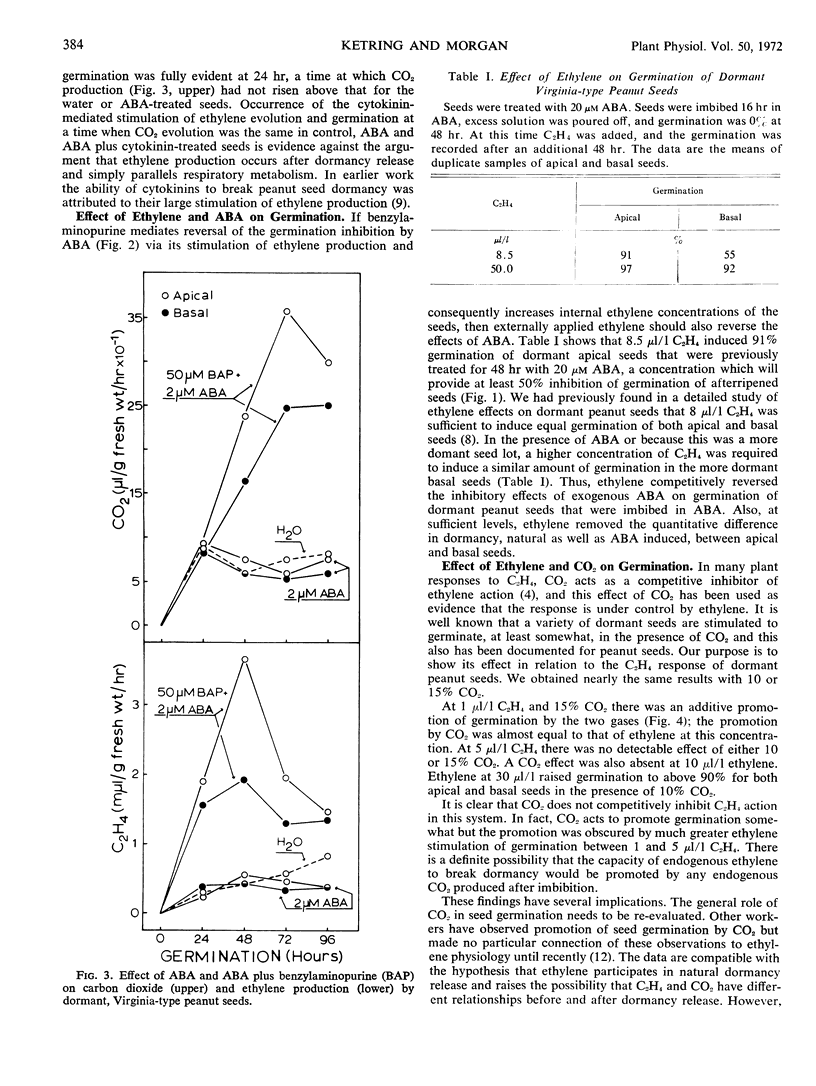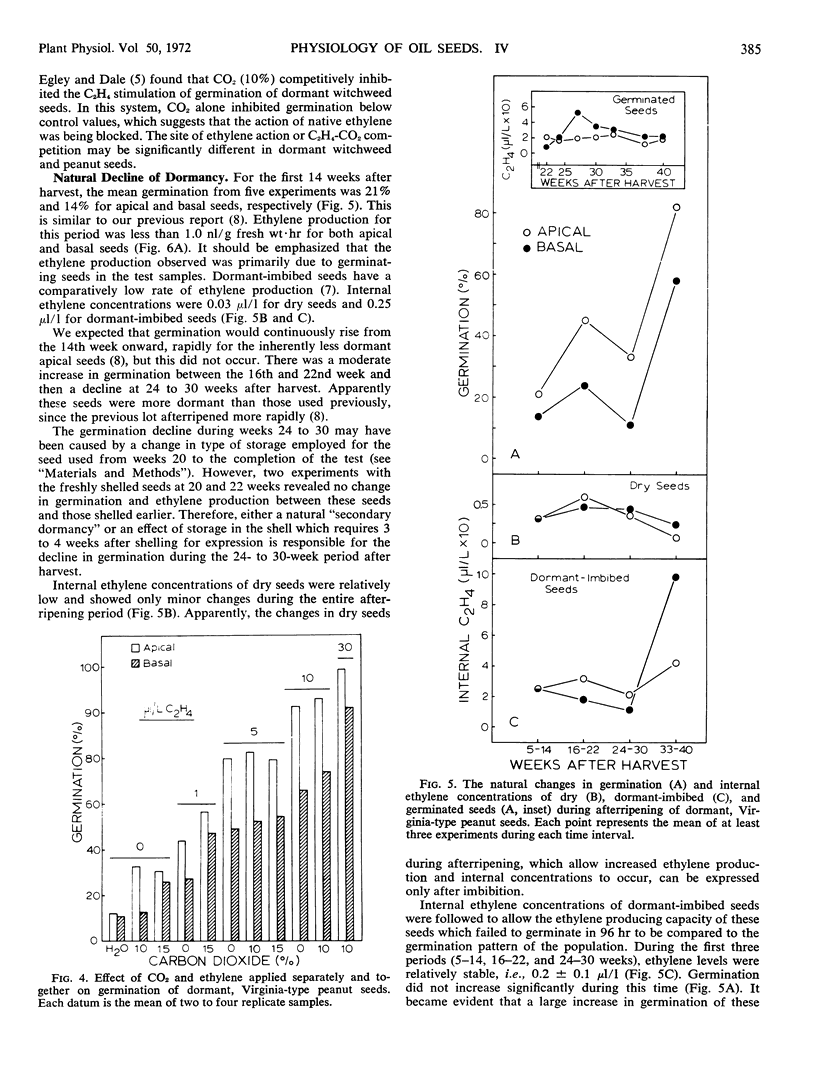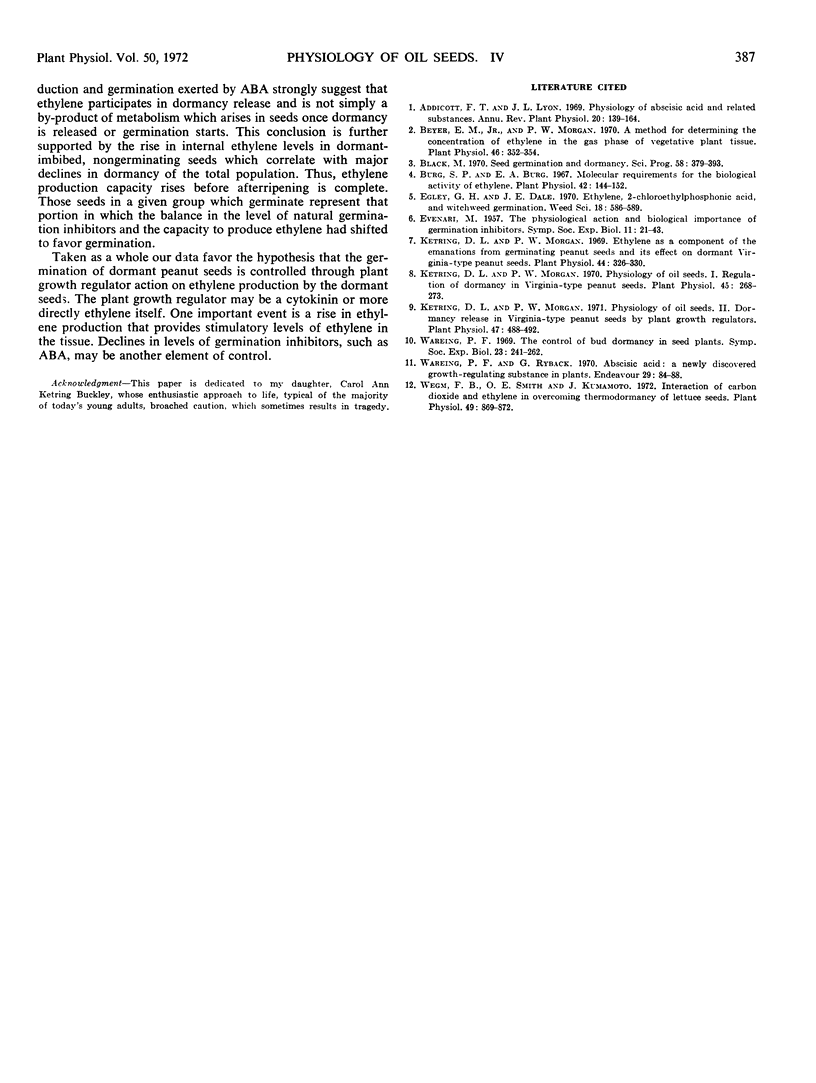Abstract
To further elucidate the regulation of dormancy release, we followed the natural afterripening of Virginia-type peanut (Arachis hypogaea L.) seeds from about the 5th to 40th week after harvest. Seeds were kept at low temperature (3 ± 2 C) until just prior to testing for germination, ethylene production, and internal ethylene concentration. Germination tended to fluctuate but did not increase significantly during the first 30 weeks; internal ethylene concentrations and ethylene production remained comparatively low during this time. When the seeds were placed at room temperature during the 30th to 40th weeks after harvest, there was a large increase in germination, 49% and 47% for apical and basal seeds, respectively. The data confirm our previous suggestion that production rates of 2.0 to 3.0 nanoliters per gram fresh weight per hour are necessary to provide internal ethylene concentrations at activation levels which cause a substantial increase of germination. Activation levels internally must be more than 0.4 microliter per liter and 0.9 microliter per liter for some apical and basal seeds, respectively, since dormant-imbibed seeds containing these concentrations did not germinate. Abscisic acid inhibited germination and ethylene production of afterripened seeds. Kinetin reversed the effects of ABA and this was correlated with its ability to stimulate ethylene production by the seeds. Ethylene also reversed the effects of abscisic acid. Carbon dioxide did not compete with ethylene action in this system. The data indicate that ethylene and an inhibitor, possibly abscisic acid, interact to control dormant peanut seed germination. The inability of CO2 to inhibit competitively the action of ethylene on dormancy release, as it does other ethylene effects, suggests that the primary site of action of ethylene in peanut seeds is different from the site for other plant responses to ethylene.
Full text
PDF





Selected References
These references are in PubMed. This may not be the complete list of references from this article.
- Beyer E. M., Morgan P. W. A method for determining the concentration of ethylene in the gas phase of vegetative plant tissues. Plant Physiol. 1970 Aug;46(2):352–354. doi: 10.1104/pp.46.2.352. [DOI] [PMC free article] [PubMed] [Google Scholar]
- Burg S. P., Burg E. A. Molecular requirements for the biological activity of ethylene. Plant Physiol. 1967 Jan;42(1):144–152. doi: 10.1104/pp.42.1.144. [DOI] [PMC free article] [PubMed] [Google Scholar]
- EVENARI M. The physiological action and biological importance of germination inhibitors. Symp Soc Exp Biol. 1957;11:21–44. [PubMed] [Google Scholar]
- Ketring D. L., Morgan P. W. Ethylene as a Component of the Emanations From Germinating Peanut Seeds and Its Effect on Dormant Virginia-type Seeds. Plant Physiol. 1969 Mar;44(3):326–330. doi: 10.1104/pp.44.3.326. [DOI] [PMC free article] [PubMed] [Google Scholar]
- Ketring D. L., Morgan P. W. Physiology of Oil Seeds: II. Dormancy Release in Virginia-type Peanut Seeds by Plant Growth Regulators. Plant Physiol. 1971 Apr;47(4):488–492. doi: 10.1104/pp.47.4.488. [DOI] [PMC free article] [PubMed] [Google Scholar]
- Ketring D. L., Morgan P. W. Physiology of oil seeds: I. Regulation of dormancy in virginia-type peanut seeds. Plant Physiol. 1970 Mar;45(3):268–272. doi: 10.1104/pp.45.3.268. [DOI] [PMC free article] [PubMed] [Google Scholar]
- Negm F. B., Smith O. E., Kumamoto J. Interaction of carbon dioxide and ethylene in overcoming thermodormancy of lettuce seeds. Plant Physiol. 1972 Jun;49(6):869–872. doi: 10.1104/pp.49.6.869. [DOI] [PMC free article] [PubMed] [Google Scholar]
- Wareing P. F. The control of bud dormancy in seed plants. Symp Soc Exp Biol. 1969;23:241–262. [PubMed] [Google Scholar]


